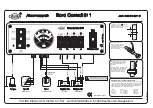
Never use pillows, books, or towels to boost a child. They can
slide around and increase the likelihood of injury or death in a
collision.
SAFETY SEATS FOR CHILDREN
Child and infant or child safety seats
Use a safety seat that is recommended for the size and weight of the
child. Carefully follow all of the manufacturer’s instructions with the
safety seat you put in your vehicle. If you do not install and use the
safety seat properly, the child may be injured in a sudden stop or
collision.
When installing a child safety seat:
•
Review and follow the information
presented in the
airbag
supplemental restraint system
(SRS) section in this chapter.
•
Use the correct safety belt buckle
for that seating position (the
buckle closest to the direction the
tongue is coming from).
•
Insert the belt tongue into the
proper buckle until you hear a
snap and feel it latch. Make sure the tongue is securely fastened in the
buckle.
•
Keep the buckle release button pointing up and away from the safety
seat, with the tongue between the child seat and the release button,
to prevent accidental unbuckling.
•
Place seat back in upright position.
•
Put the safety belt in the automatic locking mode. Refer to
Automatic
locking mode (passenger side front and outboard rear seating
positions) (if equipped)
section in this chapter.
•
LATCH lower anchors are recommended for use by children up to
48 lb. (22 kg) in a child restraint. Top tether anchors can be used for
children up to 60 lb. (27 kg) in a child restraint, and to provide upper
torso restraint for children up to 80 lb. (36 kg) using an upper torso
harness and a belt-positioning booster.
Ford recommends the use of a child safety seat having a top tether
strap. Install the child safety seat in a seating position with LATCH and
2008 Mariner
(mrn)
Owners Guide (post-2002-fmt)
USA
(fus)
Seating and Safety Restraints
134
















































